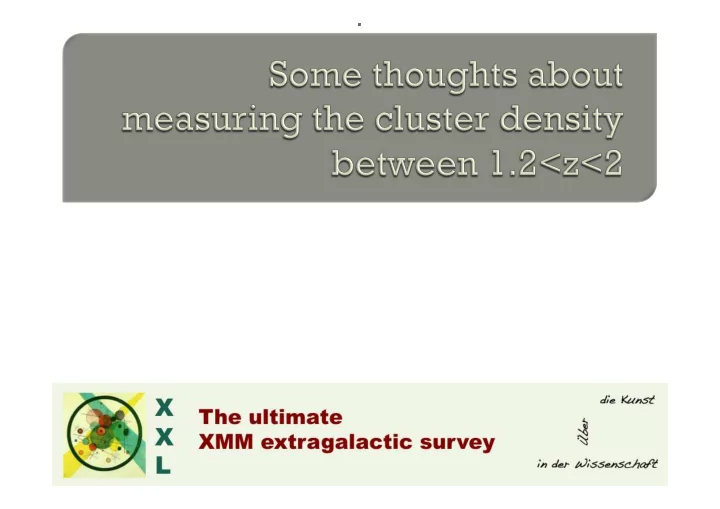

Marguerite PIERRE CEA Saclay High redshift clusters – Paris October 2016
1. Open issues 2. Current searches in XXL 3. X-ray versus MIR correlations ? 4. Further open questions
The existence of massive high redshift clusters is very sensitive to the cosmology => rare event statistics Why the z>1.2 limit? Is there any solid census of the cluster density at 1.2<z<2 ?
Not only a matter of sensitivity Wide and shallow is better than deep and narrow A well-defined selection function is mandatory
The x-ray properties can be modelled rather easily : • Ab initio analytical modelling • Hydrodynamical simulations CAVEAT: X-ray selection is not flux limited
~ surface brightness limited
Class 1 sample Core radius (arsec) Not a flux limit ! Flux (cts/s) Pacaud et al 2006
XMM VLP (2010) following XMM-LSS (2000-2010) : • 2 x 25 deg 2 area • Total time > 6Ms An international consortium gathering ~ 100 scientists. The ~ 540 XMM observations were completed in 2013
August 2016: first 14 papers out A&A special issue. • 100 brightest clusters (/450) XXL paper II, Pacaud et al • 1 000 brightest AGN (/20 000) XXL paper VI, Fotopoulou et al • Most distant cluster of XXL-100-GC is at z=1.05
XXL-N 25 deg 2 EXPO map Moon In CFHTLS-W1 2h23 -5d00 (extension of the XMM-LSS field)
XXL-S 25 deg 2 23h30 -55d00 within the SPT 100 deg2 Deep Field EXPO map
XLSSC 001 @ z=0.61
XLSSC 008 @ z=0.30 Working with these data : difficult ! : misleading (Poisson) : ambitious … but feasible and exciting !
z = 0.053 z = 1.22
I
I 3.6 µ m 4.5 µ m
Willis et al 2013 • 22 clusters at z>0.8 in XMM-LSS Mantz et al 2014 • CARMA detection of an XXL cluster • The highest redshift cluster ever detected in S-Z z phot ~ 1.9 ±0.2
A way to clean samples from contamination ? Or a nightmare to tune the correlation procedure ?
80% of the RM are found to be coincident with some X-ray emission Blind cross-matching is dangerous !
9 deg 2 XMM-LSS 18 clusters SpARCS (R-3.6 µ m) 92 clusters
Em X ≈ n 2 √ T • either there is no gas • or, the gas is not dense enough So maybe, after all, the X-ray criterion is the most reliable ?
Expected to be stronger than at z<1 Affects the selection function • either masks the cluster emission • or boosts it We have an on-going programme with Chandra to estimate the AGN contamination rate (B. Maughan)
Difficult (impossible?) task X-ray • Few photons – no hints about HE – hard to remove AGN contamination with XMM alone. K and IR bands Galaxy luminosity – uncertainties about photo-z and cluster • membership Velocity dispersion Strangely: most of the IR-detected clusters have very large σ v . • è are they really virialised ? • è filaments seen in projection ? •
Cosmo-OWLS simulations, Le Brun et al 2014 AGN X-ray contribution, Koulouridis et al, to be submitted X-ray emissivity 10 ks XMM image 7’x7’ image centred on a z = 0.95 cluster M 500 = 3.5 10 14 M – the black squares are the in-situ simulated AGN
C1 clusters C2 clusters detected in 10ks
Recommend
More recommend